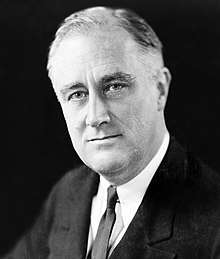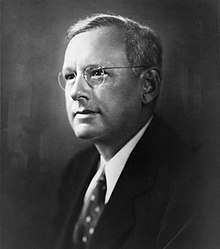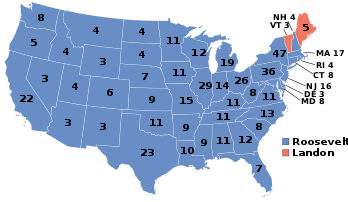1936 United States presidential election in Massachusetts
The 1936 United States presidential election in Massachusetts took place on November 3, 1936, as part of the 1936 United States presidential election, which was held throughout all contemporary 48 states. Voters chose 17 representatives, or electors to the Electoral College, who voted for president and vice president.
| |||||||||||||||||||||||||||||||||
| Turnout | 75.9%[1] | ||||||||||||||||||||||||||||||||
|---|---|---|---|---|---|---|---|---|---|---|---|---|---|---|---|---|---|---|---|---|---|---|---|---|---|---|---|---|---|---|---|---|---|
| |||||||||||||||||||||||||||||||||
 County Results
| |||||||||||||||||||||||||||||||||
| |||||||||||||||||||||||||||||||||
Massachusetts voted for the Democratic nominee, incumbent President Franklin D. Roosevelt of New York, over the Republican nominee, Governor Alf Landon of Kansas. Roosevelt ran with incumbent Vice President John Nance Garner of Texas, while Landon’s running mate was newspaper publisher Frank Knox of Illinois. Also running that year was William Lemke of the short-lived Union Party, and his running mate Thomas C. O'Brien.
Roosevelt carried the state with 51.22% of the vote to Landon’s 41.76%, a Democratic victory margin of 9.46%. Lemke came in third, with 6.45%, while in a distant fourth was Socialist Norman Thomas with only 0.28%.
Once a typical Yankee Republican bastion in the wake of the Civil War, Massachusetts had been a Democratic-leaning state since 1928, when a coalition of Irish Catholic and other ethnic immigrant voters primarily based in urban areas turned Massachusetts and neighboring Rhode Island into New England’s only reliably Democratic states.[2] Massachusetts voted for Al Smith in 1928, and for Franklin Roosevelt in his national Democratic landslide of 1932. Roosevelt’s 1936 victory thus marked the third straight win for the Democratic Party in Massachusetts, a state that had voted Democratic only once (in 1912) in its history prior to this series of consecutive Democratic wins.
However the state was still closely divided between the newly emerging Democratic majority coalition, and its traditional New England Republican roots, and consequently Massachusetts was one of FDR’s weakest victories. As Roosevelt was re-elected nationally in a massive landslide, Massachusetts weighed in as about fifteen percent more Republican than the national average. New England overall would be the only region where Landon was at all competitive; Landon’s only victories in the entire nation were neighboring Vermont and Maine. Whereas pre-New Deal Republicans from south and west of the Hudson showed very little loyalty following the Depression, in New England Republicans became galvanized to slow FDR’s expansion of the public sector.[3]
A contributing factor to Roosevelt’s relative weakness in Massachusetts was the strong showing of William Lemke in the state. Lemke and his Union Party ran on a populist platform that appealed to many working class voters who would otherwise have been natural members of Roosevelt’s New Deal coalition. While Lemke finished with only 1.95 percent nationally, in Massachusetts, Lemke received 6.45 percent of the vote, making Massachusetts his third strongest state in the nation. Lemke fared particularly well in poor Catholic precincts of Massachusetts and Rhode Island, where he even outpolled Landon in all Irish neighbourhoods save Brighton. In the poorest Irish neighbourhoods,[4] Lemke reached over 16 percent of the vote; in contrast he received less than his national average in Boston’s richest precincts.[4]
Roosevelt and Landon would split the state’s 14 counties, winning 7 counties each. However Roosevelt won the most heavily populated parts of the state including the cities of Boston, Worcester, and Springfield, while most of Landon’s wins were small or island counties.
Results
| 1936 United States presidential election in Massachusetts[5] | |||||
|---|---|---|---|---|---|
| Party | Candidate | Votes | Percentage | Electoral votes | |
| Democratic | Franklin D. Roosevelt | 942,716 | 51.22% | 17 | |
| Republican | Alf Landon | 768,613 | 41.76% | 0 | |
| Union | William Lemke | 118,639 | 6.45% | 0 | |
| Socialist | Norman Thomas | 5,111 | 0.28% | 0 | |
| Communist | Earl Browder | 2,930 | 0.16% | 0 | |
| Socialist Labor | John W. Aiken | 1,305 | 0.07% | 0 | |
| Prohibition | D. Leigh Colvin | 1,032 | 0.06% | 0 | |
| Write-ins | Write-ins | 11 | 0.00% | 0 | |
| Totals | 1,840,357 | 100.00% | 17 | ||
Results by county
| County | Franklin Delano Roosevelt Democratic |
Alfred Mossman Landon Republican |
William Frederick Lemke[6] Union |
Various candidates Other parties |
Margin | Total votes cast[7] | |||||
|---|---|---|---|---|---|---|---|---|---|---|---|
| # | % | # | % | # | % | # | % | # | % | ||
| Barnstable | 4,751 | 28.82% | 11,337 | 68.77% | 310 | 1.88% | 87 | 0.53% | -6,586 | -39.95% | 16,485 |
| Berkshire | 29,087 | 54.30% | 22,607 | 42.20% | 1,571 | 2.93% | 303 | 0.57% | 6,480 | 12.10% | 53,568 |
| Bristol | 80,805 | 57.25% | 49,754 | 35.25% | 9,765 | 6.92% | 821 | 0.58% | 31,051 | 22.00% | 141,145 |
| Dukes | 931 | 35.60% | 1,655 | 63.29% | 19 | 0.73% | 10 | 0.38% | -724 | -27.69% | 2,615 |
| Essex | 106,078 | 47.57% | 97,310 | 43.64% | 18,176 | 8.15% | 1,435 | 0.64% | 8,768 | 3.93% | 222,999 |
| Franklin | 9,324 | 39.31% | 13,756 | 57.99% | 515 | 2.17% | 126 | 0.53% | -4,432 | -18.68% | 23,721 |
| Hampden | 80,164 | 57.19% | 51,288 | 36.59% | 7,929 | 5.66% | 799 | 0.57% | 28,876 | 20.60% | 140,180 |
| Hampshire | 15,412 | 49.87% | 14,012 | 45.34% | 1,131 | 3.66% | 351 | 1.14% | 1,400 | 4.53% | 30,906 |
| Middlesex | 189,512 | 45.17% | 199,704 | 47.60% | 28,386 | 6.77% | 1,918 | 0.46% | -10,192 | -2.43% | 419,520 |
| Nantucket | 548 | 35.49% | 969 | 62.76% | 25 | 1.62% | 2 | 0.13% | -421 | -27.27% | 1,544 |
| Norfolk | 57,770 | 38.80% | 82,545 | 55.44% | 7,732 | 5.19% | 843 | 0.57% | -24,775 | -16.64% | 148,890 |
| Plymouth | 30,466 | 39.05% | 41,942 | 53.76% | 5,096 | 6.53% | 506 | 0.65% | -11,476 | -14.71% | 78,010 |
| Suffolk | 223,732 | 63.92% | 96,418 | 27.55% | 27,799 | 7.94% | 2,061 | 0.59% | 127,314 | 36.37% | 350,010 |
| Worcester | 114,136 | 54.15% | 85,316 | 40.48% | 10,185 | 4.83% | 1,127 | 0.53% | 28,820 | 13.67% | 210,764 |
| Totals | 942,716 | 51.22% | 768,613 | 41.76% | 118,639 | 6.45% | 10,389 | 0.56% | 174,103 | 9.46% | 1,840,357 |
References
- Bicentennial Edition: Historical Statistics of the United States, Colonial Times to 1970, part 2, p. 1072.
- Gamm, Gerald H.; The Making of the New Deal Democrats: Voting Behavior and Realignment in Boston, 1920-1940, pp. 81-84 ISBN 0226280616
- Gimpel, James G. and Schuknecht Jason E.; Patchwork Nation: Sectionalism and Political Change in American Politics, p. 232 ISBN 0472022911
- Sheppard, Si; The Buying of the Presidency?: Franklin D. Roosevelt, the New Deal, and the Election of 1936 (Praeger Series on American Political Culture) , p. 208 ISBN 1440831068
- "1936 Presidential General Election Results - Massachusetts". Dave Leip's Atlas of U.S. Presidential Elections. Retrieved 2013-02-07.
- Géoelections; 1936 Presidential Election Popular Vote (.xlsx file for €15 on request)
- Scammon, Richard M. (compiler); America at the Polls: A Handbook of Presidential Election Statistics 1920-1964; p. 214 ISBN 0405077114




